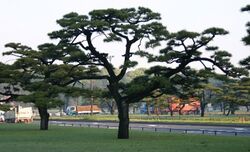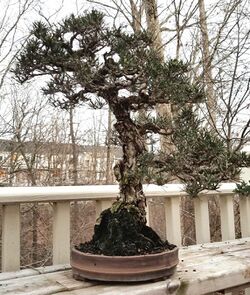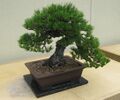Biology:Pinus thunbergii
| Black pine | |
|---|---|

| |
| Pruned black pines in Japanese National Garden, Tokyo | |
| Scientific classification | |
| Kingdom: | Plantae |
| Clade: | Tracheophytes |
| Clade: | Gymnospermae |
| Division: | Pinophyta |
| Class: | Pinopsida |
| Order: | Pinales |
| Family: | Pinaceae |
| Genus: | Pinus |
| Subgenus: | P. subg. Pinus |
| Section: | P. sect. Pinus |
| Subsection: | P. subsect. Pinus |
| Species: | P. thunbergii
|
| Binomial name | |
| Pinus thunbergii Parl.
| |
| Synonyms | |
|
Pinus thunbergiana | |
Pinus thunbergii (syn: Pinus thunbergiana), the black pine,[2] Japanese black pine,[3] or Japanese pine,[4] is a pine tree native to coastal areas of Japan (Kyūshū, Shikoku and Honshū) and South Korea.[5]
It is called Script error: The function "transl" does not exist. (곰솔) in Korean, Script error: The function "transl" does not exist. (黑松) in Chinese, and Script error: The function "transl" does not exist. (黒松) in Japanese.
Description
Black pines can reach the height of 40 metres (130 feet), but rarely achieves this size outside its natural range. The needles are in fascicles of two with a white sheath at the base, 7–12 centimetres (2 3⁄4–4 3⁄4 inches) long; female cones are 4–7 cm (1 1⁄2–2 3⁄4 in) in length, scaled, with small points on the tips of the scales, taking two years to mature. Male cones are 1–2 cm (1⁄2–3⁄4 in) long borne in clumps of 12–20 on the tips of the spring growth. The bark is gray on young trees and small branches, changing to black and plated on larger branches and the trunk; becoming quite thick on older trunks.[2][3] It is a widely adapted plant with attractive dark green foliage.[6]
Ecology
In North America this tree is subject to widespread mortality by the native American pinewood nematode, Bursaphelenchus xylophilus, spread by means of beetle vectors. Subsequently, blue stain fungus invades the plant, leading to a rapid decline and death. This nematode has also been introduced to Japan accidentally, leading to the species becoming endangered in its native area.[citation needed]
Uses
Because of its resistance to pollution and salt, it is a popular horticultural tree. In Japan it is widely used as a garden tree both trained as Niwaki and untrained growing as an overstory tree. The trunks and branches are trained from a young age to be elegant and interesting to view. It is one of the classic bonsai subjects, requiring great patience over many years to train properly.[citation needed]
Second flush of growth
One characteristic of the Japanese black pine that makes it desirable for bonsai, is the possibility of inducing a second flush of new growth and improved ramification in a single growing season. Unlike most pines, which are single flush plants, the Japanese black pine can be induced to produce new buds at the base of each spring candle by simply cutting the candles at the base as they elongate, a technique called decandling. This technique will result, in a few weeks, in the flush of multiple new buds at the base of the cut candle; each of these new buds will result in turn in new candles and branches.[7]
Gallery
References
- ↑ Farjon, A. (2013). "Pinus thunbergii". IUCN Red List of Threatened Species 2013: e.T42423A2979140. doi:10.2305/IUCN.UK.2013-1.RLTS.T42423A2979140.en. https://www.iucnredlist.org/species/42423/2979140. Retrieved 12 November 2021.
- ↑ 2.0 2.1 English Names for Korean Native Plants. Pocheon: Korea National Arboretum. 2015. pp. 575. ISBN 978-89-97450-98-5. http://www.forest.go.kr/kna/special/download/English_Names_for_Korean_Native_Plants.pdf. Retrieved 17 December 2016.
- ↑ 3.0 3.1 "Pinus thunbergii". Natural Resources Conservation Service PLANTS Database. USDA. https://plants.usda.gov/core/profile?symbol=PITH2.
- ↑ "Pinus thunbergii (クロマツ, Japanese black pine) description". https://www.conifers.org/pi/Pinus_thunbergii.php.
- ↑ Flora of China.
- ↑ "SelecTree: A Tree Selection Guide". https://selectree.calpoly.edu/tree-detail/1081.
- ↑ "Decandling black pine bonsai - an in-depth guide - Bonsai Tonight". 22 July 2016. https://bonsaitonight.com/2016/07/22/decandling-black-pine-bonsai-overview/.
Further reading
- Fu, Liguo; Li, Nan; Elias, Thomas S.; Mill, Robert R., "Pinus thunbergii", Flora of China, 4, http://www.efloras.org/florataxon.aspx?flora_id=2&taxon_id=200005368, retrieved 2018-08-16
External links
| Wikimedia Commons has media related to Pinus thunbergii. |
Wikidata ☰ Q854884 entry
 |










